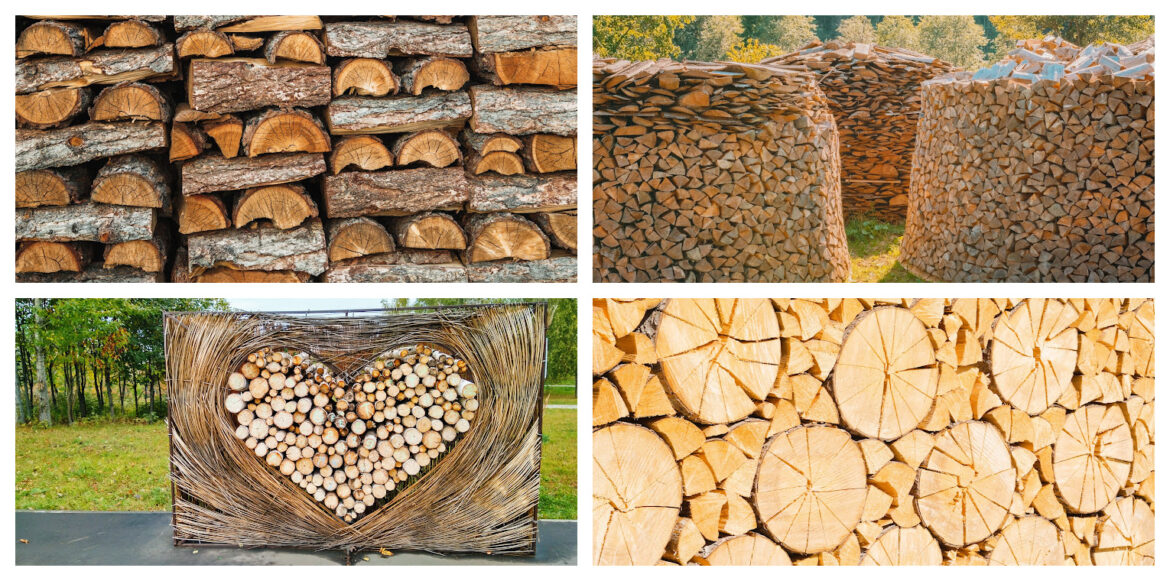If you have recently purchased a wood burning fireplace, stove or insert or if you’re a seasoned old wood tick, this article has important details regarding stacking and drying your fuel supply. It’s critical to burn dry wood, but is there a best way to stack and allow wood to dry? Please keep reading to get some valuable tips for getting the optimal performance from your wood burning appliance.
HOW TO STACK WOOD SO IT DRIES NATURALLY?
The most important point when stacking firewood is doing it in a way that will allow the wood to dry naturally and then to stay dry. First of all, do not stack firewood directly on the ground. Use some sort of dry platform such as concrete, treated timbers or a wood rack. The objective is to prevent the lower layers from decaying from all the moisture in the ground. Wood that is soft and punky is starting to rot and is not useable as firewood.
After the wood has been cut to your preferred length, make sure larger pieces have been split. Split wood dries much better from both the side grain being exposed than just through the end grain cuts. A good rule of thumb: if the wood is 5 or 6 inches in diameter or more, split it.
Position the wood so the end cuts are open and do not pack the firewood too tight when stacking it. The whole idea is to allow the breeze to be able to easily move through the pile, especially when the sun is out. Firewood dries much slower in the wintertime. Sunlight is also very important for drying wood, but shortened daylight hours in winter are not particularly helpful. The drier winter air helps pull moisture from the wood, but this process is slower than in warmer weather.
As you can see, there are several different methods and patterns that can be used when stacking wood. Many people take considerable pride in the appearance of their wood pile. Some of these techniques actually take on an art form! But the goal of thoroughly drying the wood is the same regardless of how the wood pile looks and how long it takes to stack it. If you have the time and inclination to get creative, go for it! Just keep in mind your basic objective is to get the wood dry enough to efficiently burn it.

SHOULD I COVER THE WOOD OR LEAVE IT UNCOVERED?
It’s always best to keep the rain, ice and snow off your firewood. A roof over your wood pile will protect it, but be sure to slope the roof away from the piles base. Side walls on a small shed will protect the wood supply from strong winds and driving snow and rain. Many folks will leave one side of a wood shed completely open with small openings between the boards in the other three sidewalls. This technique will still allow the wind to move through the wood. If you’re planning to build a wood shed, keep in mind the prevailing wind direction.
A good practice with split wood is to place the rounded, bark-covered side up. By doing so, whatever rain that gets to the wood pile, can easily run off.
It’s not a good idea to tarp your wood pile. By tarping the entire wood pile, moisture will be trapped and decay can be expedited. If you use a tarp, only cover the top layer of wood.
What about storing wood in a garage, shed or barn? Great spots for keeping the rain and snow off, but two main issues here. One, there isn’t much airflow inside a garage or barn. Opening doors and windows will help a lot. It’s important to ensure the wind is able to get to the wood pile. Secondly, if the garage is attached to the house, the bugs, bark and dirt will likely find a way inside the home.

HOW LONG DOES IT TAKE FIREWOOD TO DRY?
Generally speaking, and depending where you are geographically, it takes a minimum of six to eight months to dry firewood to the point where you can efficiently burn it. It can be difficult to do, but a great practice to strive for is to get a year ahead with your wood supply. Cut it, split it, stack it and cover it today and burn it one year from now.
How dry is dry enough? Use a moisture meter and get the moisture content below 25%. These meters are easy to use and are available at your local hardware store or online. For less than $50.00, they’re a good investment.
With experience, you’ll be able to knock two pieces of wood together and get a good idea by sound and by weight if the wood is dry enough to burn.
CAN I STACK FIREWOOD RIGHT NEXT TO THE HOUSE?
This is probably an individual decision, but consider these points: Skunks and other critters have been known to enjoy hanging out in and around wood piles. Bugs often spend the winter beneath the bark. And, from an aesthetics point of view, it may look a bit tacky having a wood shed or wood pile connected onto the side of your house.
It probably would be best to keep your firewood at least 25 to 30 feet (or more) from your house. Keep in mind that too far away isn’t good either. There are people every year that cannot get to their wood supply because of nasty snow drifts during a severe storm. Even in decent weather, you’ll want to minimize steps with a wheelbarrow full of wood or if you use a log carrier. Try to keep at least 3 or 4 days of wood supply handy and accessible in a wood box in your garage or in a wood rack by your fireplace, stove or insert.
REMEMBER THESE POINTS WHEN STACKING YOUR FIREWOOD:
- Raised up off the moist ground.
- Split any pieces larger than 5 or 6 inches in diameter.
- Protect it from the rain, ice and snow.
- Do not pack too tightly together.
- Get a year ahead in preparing your wood supply.
- Open to free air to allow the sun and wind to dry it out and carry moisture away.
- Check the moisture content before burning.
- Keep it dry.











